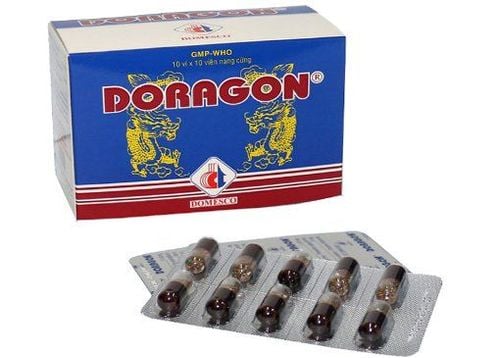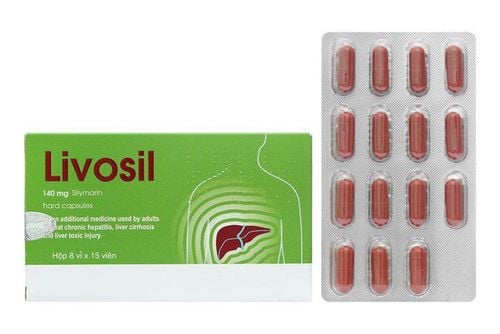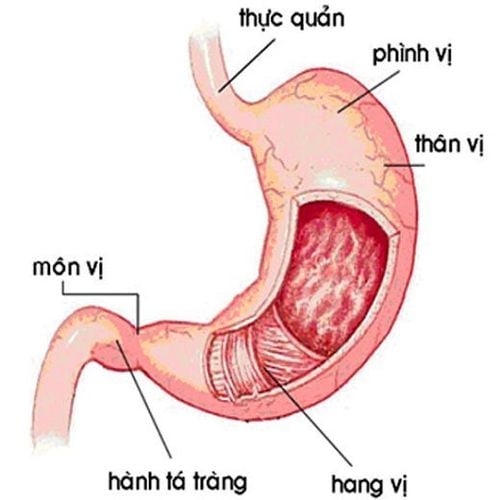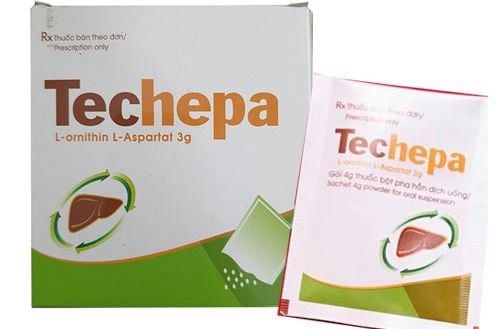This is an automatically translated article.
The article is written by Master, Doctor Mai Vien Phuong - Gastroenterologist - Department of Medical Examination & Internal Medicine - Vinmec Central Park International General Hospital. Doctor has nearly 10 years of experience in the field of Gastrointestinal Endoscopy.Metabolic-associated fatty liver disease (MAFLD) also known as non-alcoholic fatty liver disease (NAFLD) has become the most common cause of chronic liver disease in the Western world. However, optimal therapy has not yet been discovered and is currently based on identification of risk factors with dietary and lifestyle modifications.
1. The role of weight loss in the treatment of nonalcoholic fatty liver disease
Numerous studies have shown a positive effect of weight loss in improving MAFLD and preventing the progression of non-alcoholic steatohepatitis (NASH)/cirrhosis. A 5% weight loss through calorie restriction has been shown to improve adiposity, a 5% to 7% weight loss leads to an improvement in inflammation, and a 7%-10% weight loss leads to increased capacity NAFLD/NASH remission and fibrosis improvement.The investigation by Hohenester et al showed that 11.8% of patients demonstrated liver fibrosis at baseline through the NAFLD fibrosis score. After weight loss, 0% of patients developed fibrosis at 52 weeks (P < 0.05). However, an earlier randomized controlled trial with a mean weight loss of 9.3% did not confirm a significant change in liver fibrosis, despite an improvement in the NASH histological activity score in 31 patients over 48 weeks. Several studies have shown histological improvement, including reduction in fibrosis after spondylectomy. In a systematic review, a meta-analysis of pre- and postoperative histological findings demonstrated a mean reduction in fibrosis rate of 11.9% (P < 0.0001) in obese patients with MAFLD spanning through laminectomy. Similar findings were also found in a systematic review and meta-analysis performed by Mummadi et al, in which 65.5% of patients combined showed improvement or resolution of the condition. fibrosis after weight loss due to end-stage surgery.

2. Role of Vitamin E
The results of multiple trials have led to current recommendations for the use of Vitamin E (800 IU/day) or pioglitazone for the treatment of non-alcoholic fatty liver disease in non-diabetic patients. This trial was a large randomized controlled trial of vitamin E versus pioglitazone and placebo in which 247 adults with biopsy-confirmed nondiabetic NASH were assigned to 1 of 2 treatment groups. Use of both drugs was associated with significant reductions in steatosis, lobular inflammation, and liver enzymes compared with placebo, but no reduction in the grade of liver fibrosis. It is important to note that caution should be exercised when prescribing these drugs as data suggest an increase in all-cause mortality and prostate cancer with Vitamin E. Side effects are common. Weight gain and bone loss should also be considered when prescribing thiazolidinediones, such as pioglitazone.
3. The role of fibroblast growth factor (FGF)
Other areas of investigation for sclerotherapy in NASH include fibroblast growth factor (FGF). FGF19 is a polytrophic protein that has been shown to decrease gluconeogenesis and increase insulin sensitivity, inhibit fatty acid synthesis, increase hepatic glycogen and protein synthesis, and regulate bile acid homeostasis. In a recent phase 2 study, Aldafermin (NGM282), an FGF19 analog, demonstrated histological improvement in patients with NASH. After 12 weeks of treatment, paired liver biopsies showed a decrease in nonalcoholic fatty liver disease (NAS) activity scores in both the 1 mg and 3 mg treatment groups (P < 0.001), as well as a decrease in fibrosis scores. in the 3 mg group (P = 0.035).Results also demonstrated NAS improved by 2 points or more without fibrosis in 50% and 63% of patients in the 1mg or 3mg treatment group, respectively (NCT02443116). In the phase 2 trial, the authors noted gastrointestinal adverse events including nausea, abdominal pain, diarrhea, and injection site reactions following administration of NGM282. FGF21 is similar, as it plays multiple roles in metabolism, including fatty acid oxidation, lipolysis, and gluconeogenesis. Pegbelfermin (BMS-986036) is a pegylated human FGF21 analogue, and has shown a significant reduction in absolute liver fat in the 10 mg daily group (-6.8% vs -1.3%) ; P = 0.0004) and in the weekly 20 mg subgroup (-5.2% vs -1.3%; P = 0.008) vs placebo in patients with NASH stages 1-3 (NCT02413372) . Common side effects of drug treatment include diarrhea and mild nausea.
4. The role of hepatocellular inhibitor PF-05221304
A recent trial demonstrated the efficacy of PF-05221304, a liver-targeted inhibitor of acetyl-coenzyme A carboxylase, thereby interfering with de novo adipogenesis (NCT02871037). Healthy subjects demonstrated dose-dependent reductions in liver fat, liver enzymes, and hemoglobin A1c. Minimal adverse events included elevation of serum triglycerides, headache, diarrhea and one case of thrombocytopenia leading to withdrawal from the study. Although this study did not directly measure liver fibrosis, future studies may demonstrate that the decrease in de novo lipogenesis secondary to this drug leads to fibrosis degeneration in addition to the reduction in inflammation.Drugs in phase 3 clinical trials and other promising therapies for the treatment of nonalcoholic steatohepatitis.
The drug is currently in phase 3 investigative trials for the treatment of nonalcoholic steatohepatitis according to ClinicalTrials.gov.
| Tên thuốc | Cơ chế hoạt động | Hoàn thành dự kiến | Nghiên cứu / định danh |
| Resmetirom (MGL-3196) | Chất chủ vận thụ thể hormone tuyến giáp | Tháng 3 năm 2024 | [MAESTRO-NASH] NCT03900429 |
| Dapaglifozin | Chất ức chế SGLT-2 | Tháng 11 năm 2021 | [DEAN] NCT03723252 |
| Aramchol | Chất ức chế SCD1 | Tháng 12 năm 2024 | [ARMOR] NCT04104321 |
| Cenicriviroc | Chất đối kháng CCR2-CCR5 | Tháng 10 năm 2028 | [AURORA] NCT03028740 |
| Elafibranor | Chất chủ vận PPAR | Tháng 12 năm 2021 | [GIẢI QUYẾT-IT] NCT02704403 |
| Axit có cồn | Chất chủ vận FXR | Tháng 10 năm 2022 | [ĐĂNG KÝ] NCT02548351 |
4.1 Alcoholic acids Farsenoid X receptor is a nuclear hormone receptor that has been shown to negatively regulate nuclear factor kappa B signaling involved in hepatitis and its subsequent role in development NASH. Obeticholic acid (OCA) is an agonist of the Farsenoid X receptor and has been shown to increase insulin sensitivity while reducing steatosis and cirrhosis. In a phase 2 placebo-controlled double-blind trial (FLINT; NCT01265498), 283 patients were randomized to receive OCA or placebo for 72 weeks. All participants had a baseline NAFLD activity score of 4 or higher, with a score of 1 or higher in each of the three categories (steatosis, bubbling, and lobular inflammation).
Promising results with OCA meet NAS primary outcome improvement ≥2 points without worsening of fibrosis (45% vs 21%, P=0.002) and improvement of fibrosis ( 35% vs 19%, P = 0.004) when compared with placebo. OCA treatment is associated with lower HDL cholesterol, and higher serum triglycerides and cholesterol. Other adverse events, including pruritus, were reported in 23% of OCA-treated patients compared with 6% of placebo-treated patients (P<0.0001).
Currently conducting a phase 3 trial (REGENERATE; NCT02548351), in which non-cirrhotic NASH subjects with stage 2 or 3 fibrosis were randomized to receive OCA 10 mg, OCA 25 mg, or placebo. A recently published 18-month interim analysis showed an improvement in fibrosis (≥1 stage) of 18% in the OCA 10 mg group (P = 0.045) and 23% in the OCA 25 mg group (P = 0.0002) ). The most common adverse event was mild to moderate pruritus, which occurred in 51% of patients receiving 25 mg OCA. Investigation into the safety and efficacy of this drug is underway in a phase 3 trial (REVERSE; NCT03439254) in patients with compensated cirrhosis due to NASH.
4.2 Selonsertib Selonsertib (SEL) is an inhibitor of apoptosis signaling kinase 1 (ASK-1). During periods of oxidative stress, ASK-1 induces apoptosis, cell death, and production of inflammatory cytokines. In the phase 2 trial, NASH patients with stage 2-3 fibrosis were randomized to receive either 6 mg or 18 mg of SEL with or without a once-weekly injection of 125 mg simtuzumab or simtuzumab alone for 24 weeks. Patients treated with selonsertib alone seem to show improvement in fibrosis and a lower rate of fibrosis progression, as indicated by MR elastography and liver biopsy. However, these results were not reproduced in the phase 3 study (STELLAR-3; NCT03053050) in NASH patients or in patients with bridging fibrosis and compensated cirrhosis (STELLAR-4; NCT03053063), resulting in the Discontinue study after provisional analysis. Importantly, patients in the selonsertib group experienced a greater incidence of headache, nausea, abdominal pain, sinusitis, nasopharyngitis, and fatigue. There were also cases of serious adverse events and three patients discontinued treatment due to worsening schizophrenia, facial and upper extremity numbness, and elevated liver enzymes.

After post hoc analysis, NASH resolved without exacerbation of fibrosis at a higher rate in the 120 mg group compared with placebo (P = 0.045). Patients with NAS ≥ 4, demonstrated resolution of NASH, based on the protocol definition, with a greater prevalence on treatment with elafibranor 120 mg (P=0.018) and modified definitions (P= 0.013).
It is important to note that there was no significant difference between treatment and placebo based on the primary outcome of the regimen (resolution of NASH without worsening of fibrosis). Although the therapy was well tolerated by the recipients, continued monitoring of renal failure was required because elevations in serum creatinine were observed in study participants. Recently, an interim analysis was published by GENFIT of an ongoing phase 3 trial (RESOLVE-IT; NCT02704403) that analyzed elafibranor 120mg versus placebo in moderate to severe NASH. The results showed no significant difference between the two groups when analyzing the primary endpoint (NASH resolution without aggravation of fibrosis) or the important secondary endpoint (improvement of fibrosis by at least one stage). paragraph).
4.4 Cenicriviroc Cenicriviroc is an antagonist of chemokine receptor 2 and chemokine receptor 5, which are sites that bind to the inflammation-promoting chemokines CCL2 and CCL5 resulting in cell-promoting inflammation and liver injury. A double-blind, randomized, phase 2 study (CENTAUR; NCT02217475), assigned patients with NASH and cirrhosis (stages 1-3) to cenicriviroc 150 mg versus placebo. Subjects receiving cenicriviroc showed a 1-stage reduction in fibrosis and no more severe steatohepatitis than placebo (20% vs 10%; P=0.02).
Surprisingly, those with higher disease activity (NAS 5) and fibrosis at baseline, showed a better response to therapy. The final data of the 2-year study also showed similar findings with sustained fibrosis reduction in responders. Adverse effects include fatigue and diarrhea in a small percentage of patients. There is currently an ongoing phase 3 trial (AURORA; NCT03028740), enrolling patients with F2-F3 fibrosis to evaluate histological and clinical outcomes.
4.5 Liraglutide/semaglutide Liraglutide and semaglutide are glucagon-like peptide (GLP)-1 (incretin mimetics) analogues used to treat type 2 diabetes. These drugs stimulate endogenous insulin release from pancreatic cells and decrease glucagon release. Clinical trial (LEAN; NCT01237119) demonstrated that once-daily injection of liraglutide resulted in resolution of NASH without exacerbation of fibrosis when compared with placebo (39.1% vs 9%; P = 0.02).
In addition, patients in the placebo group had significantly greater fibrosis progression compared with liraglutide (P = 0.04). Semaglutide is currently being investigated as a therapeutic agent to address NASH without exacerbating fibrosis with a secondary outcome of amelioration of liver fibrosis (NCT02970942). Initial data including 230 patients with fibrosis stages F2 to F3, demonstrated resolution of NASH in the semaglutide group compared with placebo (59% vs 17%). GLP-1 receptor agonists have shown beneficial cardiovascular, mortality, and renal outcomes in patients with type 2 diabetes, and therefore may hold great promise in the treatment of NASH with diabetes.

To protect everyone's health, now, Vinmec International General Hospital provides customers with standard to advanced hepatobiliary screening packages to help diagnose cirrhosis in particular and hepatobiliary diseases. Generally speaking.
Vinmec is the leading prestigious and reliable address in the field of screening and treatment of hepatobiliary diseases, with the following outstanding advantages:
As one of the few hospitals across the country applying ultrasound Liver tissue recovery (also known as ARFI technique) to monitor liver disease, assess the degree of cirrhosis such as imaging, test kits from basic to advanced. With the state-of-the-art LOGIQ E9 ultrasound system, a powerful and flexible ultrasound imaging system that meets a wide range of general examination needs. New technology using Shear Wave: This is a technology that allows qualitative and quantitative measurement of the elastic energy of the parenchyma through a color-coded table along with the value of elastic levels in Kpa pressure units. A team of specialists and specialists with extensive experience and expertise helps the treatment process to be highly effective, shortening the treatment time. Professional, comprehensive examination and consultation service, civilized, polite, safe and sterilized medical examination space. >>See more: Advances in the treatment of non-alcoholic steatohepatitis - Article written by Master, Doctor Mai Vien Phuong - Gastrointestinal endoscopist - Department of Examination & Internal Medicine - General Hospital Vinmec Central Park International Faculty. Doctor has nearly 10 years of experience in the field of Gastrointestinal Endoscopy.
Please dial HOTLINE for more information or register for an appointment HERE. Download MyVinmec app to make appointments faster and to manage your bookings easily.
ReferenceToosi AE. Liver Fibrosis: Causes and Methods of Assessment, A Review. Rom J Intern Med. 2015;53:304-314. [PubMed] [DOI] Konstantinos Damiris, Efficacy and safety of anti-hepatic fibrosis drugs, World J Gastroenterol. Nov 7, 2020; 26(41): 6304-6321














